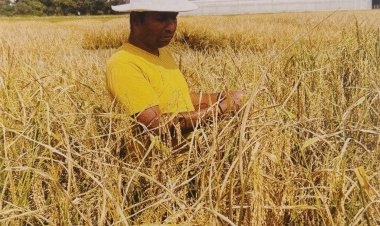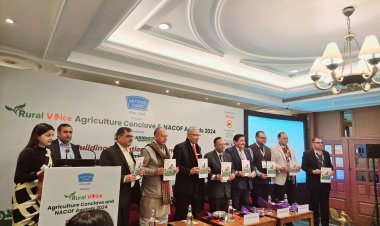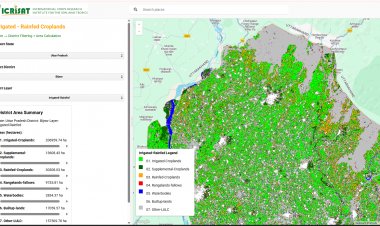Budget 2021-22 and Rural Development: Implementation is the Key
Most of the programmes/schemes are being implemented by the Panchayats at grassroots levels. Here, the issue is the governance of the Panchayati Raj Institutions at the village, block and district levels. Even if funds under different programmes have been enhanced but the governance at the local level has not improved, the benefits of the programmes might not percolate to the desired levels.

Budget 2021-22 is really a never-before one because it has been presented at a time which was never so in the past. Covid-19 has put society and the economy on the back burner. Not only this, inequality has increased during the Covid period, as is evident from the report of the ‘World Inequality Lab’, which revealed that the top 10 rich persons’ earnings have increased from 30 per cent in 1980 to 56 per cent in 2019. At home, the top 11 rich persons’ incomes have increased so much during the Covid period that they can finance the corona vaccination to the needy in the country. On the other end of the spectrum, the income of the employees of the organized sector decelerated 12 per cent during this period.
According to an Oxfam survey, women were more victimized during the Covid period because their unemployment rate is 15 per cent. Millions of workers and their families were forced to migrate to rural areas, where they did not get jobs and other amenities like health facilities. Most of them did not get desired benefits under various programmes like the Mahatama Gandhi National Rural Employment Guarantee Scheme (MGNREGA) because they did not have any role in village politics. Farmers are not getting their dues from the sugarcane mills. Open unemployment, underemployment and disguised unemployment have been increasing. Capital investment in rural areas has been sputtering. In such a scenario, it was expected that Budget 2021-22 would address these issues by proposing the requisite funds and measures for improving governance at the local level.
In the above background, let us examine the contents of the Budget proposals in the rural context. Let us take a few examples of the Revised Estimates (RE) of 2020-21 and the Budget Estimates (BE) of 2021-22 and compare the two to know the status of their resource allocation. For instance, under MGNREGA, RE 2020-21 was Rs. 1,11,500 crores while BE 2021-22 for this programme is merely Rs. 73,000 crores. The BE is 34 per cent less than the RE last year. In view of the plight of labour and more investment in agriculture and allied sector, it should have been at the RE level of 2020-21. Similarly, under the National Social Assistance Programme, RE 2020-21 was Rs. 42,617.12 crores, which has been reduced to Rs. 9,200 crores in BE 2021-22. This should have also been on the higher side. The Budget outlay under the National Rural Livelihood Mission has been increased by 45 per cent from RE 2020-21. This is a welcome step as it would not only engage women in micro-credit and micro enterprises at the village level but also organize them socially for their betterment. The BEs under the umbrella programmes for the development of Scheduled Tribes (STs) and Scheduled Castes (SCs) have been increased. But the issue here is that the REs for 2020-21 under these programmes are less than the BEs for the same year. This indicates that the allocated funds are not spent.
Most of the programmes/schemes are being implemented by the Panchayats at grassroots levels. Here, the issue is the governance of the Panchayati Raj Institutions at the village, block and district levels. If funds under different programmes have been enhanced but the governance at the local level has not improved, the benefits of the programmes might not percolate to the desired levels. Finance Minister in her budget speech mentioned six pillars on which the Budget is based and among these are inclusiveness, and minimum government and maximum governance. But, if seen in the local context, nothing has been addressed. For instance, when meetings of Gram Sabhas, Gram Panchayats, various subject committees like production committee, social justice committee, amenities committee, finance, audit and planning committee, and health committee are not taking place, how would plans be prepared in participatory mode and how would funds be used properly for what they have been allocated? Leave aside their regular meetings, the committees have not even been constituted. If these committees are constituted the participation of SCs, STs and women might be achieved. For example, there are about 2,50,000 Panchayats and six lakh villages across the country. More than 32 lakh elected representatives are working at different levels in these Panchayats. Among them, 14 lakh are women and 10-12 lakh are SCs/STs. In such a situation, where is inclusiveness and where is governance when rules and bye-laws have not been put into practice? There could have been incentives in the budget to panchayats where the meetings of Gram Sabha, Gram Panchayat, standing committees and subject committees are held regularly.
It is mentioned that under the Gram Panchayat Development Plan, a ward-level plan will also be prepared where ward members would be engaged. But where is the ward plan? Article 243G of the Constitution says that Panchayats are expected to prepare the plan for economic development and social justice, including the 29 subjects listed in the 11th Schedule of the Constitution. But the million-dollar question is: where is such a plan even after almost three decades of the implementation of the 73rd Amendment Act. Thus, the grassroots stimulus in the guise of governance for better outcomes should have been an integral part of the Budget proposals of the Finance Minister. In the scenario that we have at present, how would local be vocal?
It is a welcome step that the Swamitva Scheme (SS), which was in pilot project mode in six states, namely Haryana, Karnataka, Madhya Pradesh, Maharashtra, Uttar Pradesh and Uttarakhand covering about one lakh villages, has been extended to all States and UTs. This scheme aims at (i) providing documentary proof of residential properties; (ii) ensuring clarity on property rights of people; (iii) facilitating the preparation of planning and revenue collection; (iv) help in resolving property-related disputes; (v) help in preparation of better-quality Gram Panchayat Development Plans (GPDPs) leveraging the maps created under this programme; (vi) providing an integrated property validation solution for rural India, engaging the latest Drone Surveying technology, for demarcating the inhabitant (aabadi) land in rural areas; and (vii) mapping of rural housing land using the latest survey methods and drones. It is expected that this would be carried out in convergence mode with the efforts of the Ministry of Panchayati Raj, the State Panchayati Raj Departments, the State Revenue Departments and the Survey of India.
However, there are challenges in the implementation of the Scheme in fields where farmers go to any extent to save land which he has encroached upon. There are more challenges in locating the agricultural land illogically possessed by a person or family. If a piece of land or a pond is located in the vicinity of habitats, has been encroached upon by villagers who have subsequently constructed houses on them, how would it be freed by the administration? In fact, due to the laxity of action on the part of the Panchayats, villagers have encroached upon some important common land and water sources. Here also the issue is the implementation of the scheme in letter and spirit.
Dr. Mahi Pal, Indian Economic Service (Retd), is President, Karpa Foundation. The views here are personal.



 Join the RuralVoice whatsapp group
Join the RuralVoice whatsapp group








































